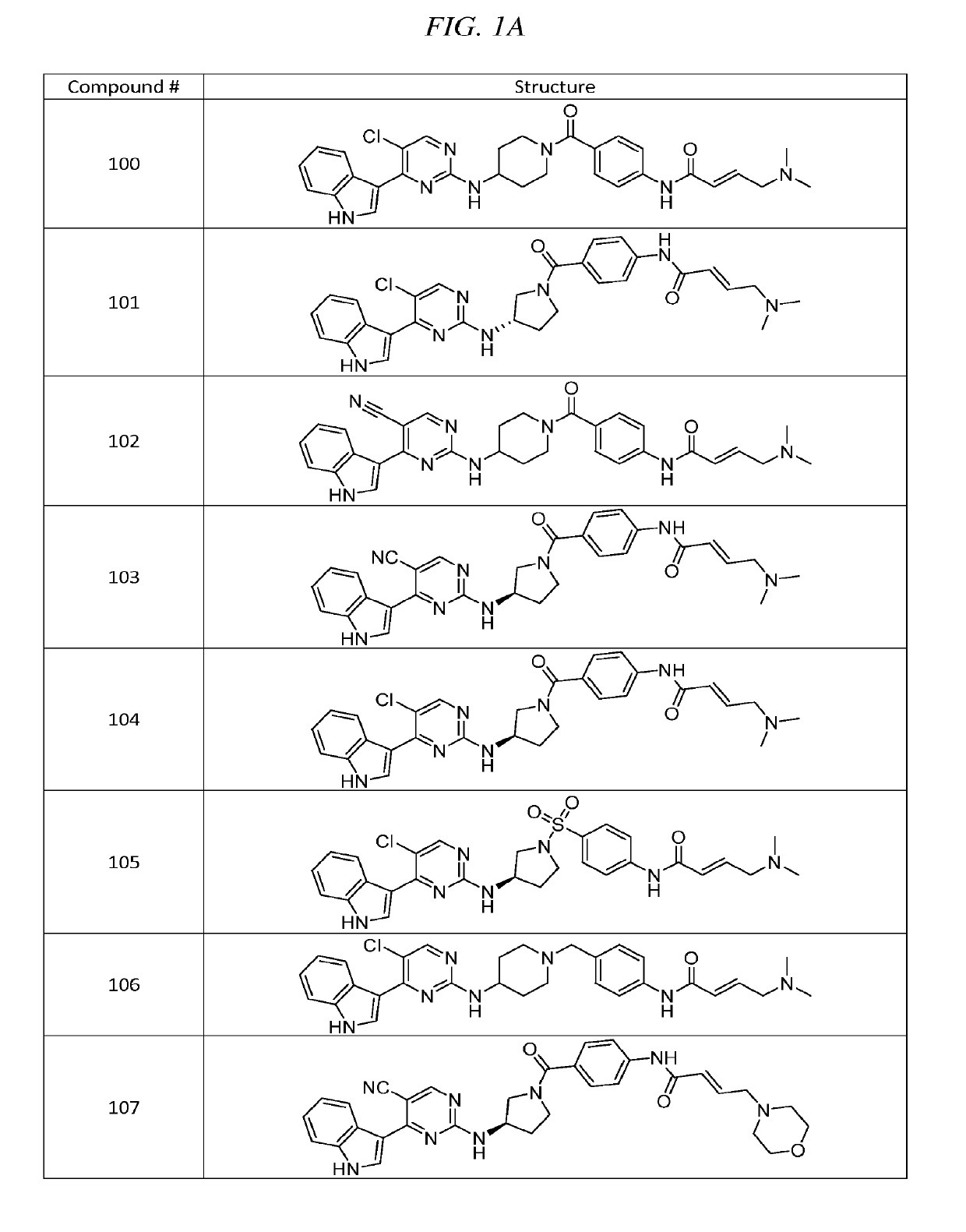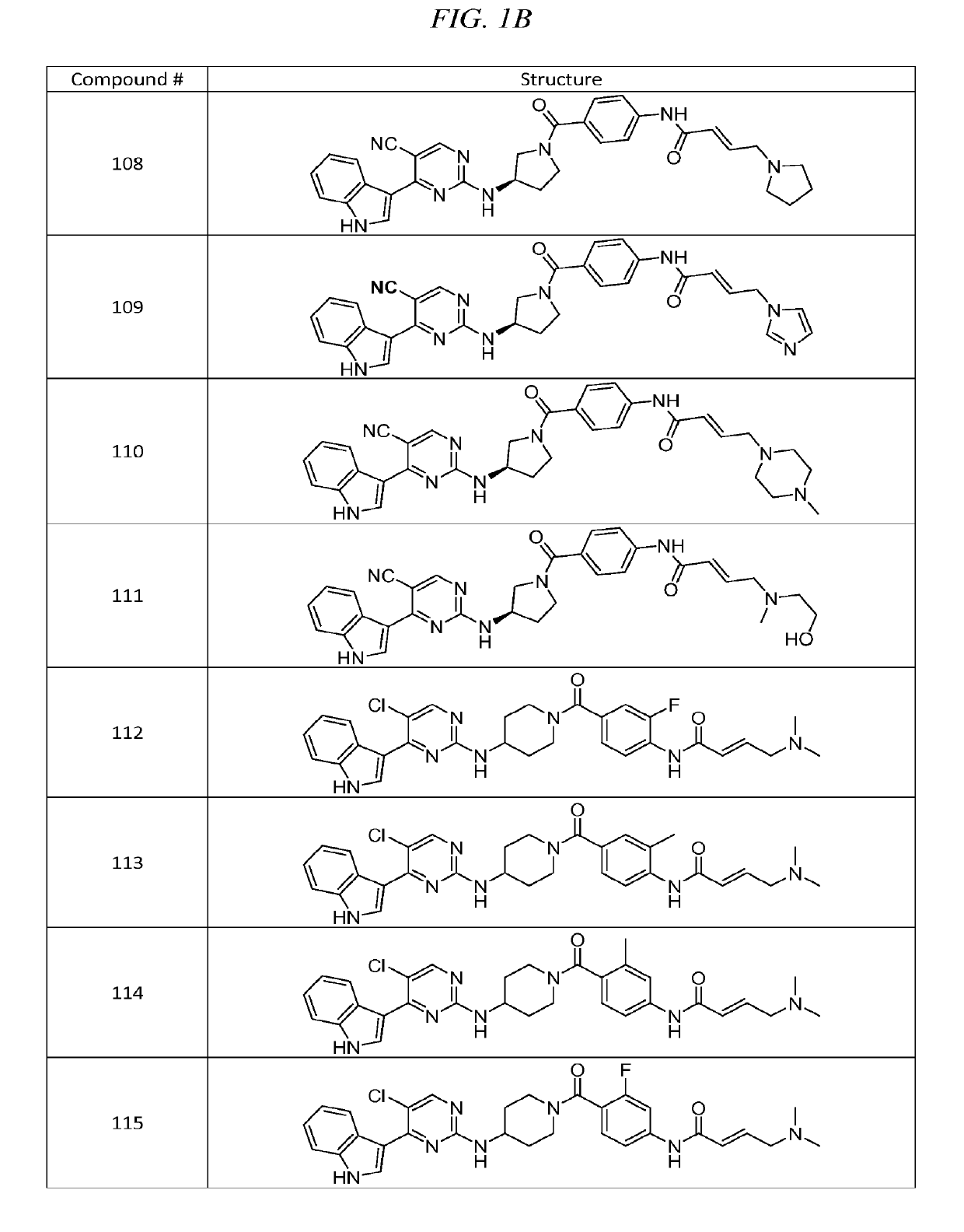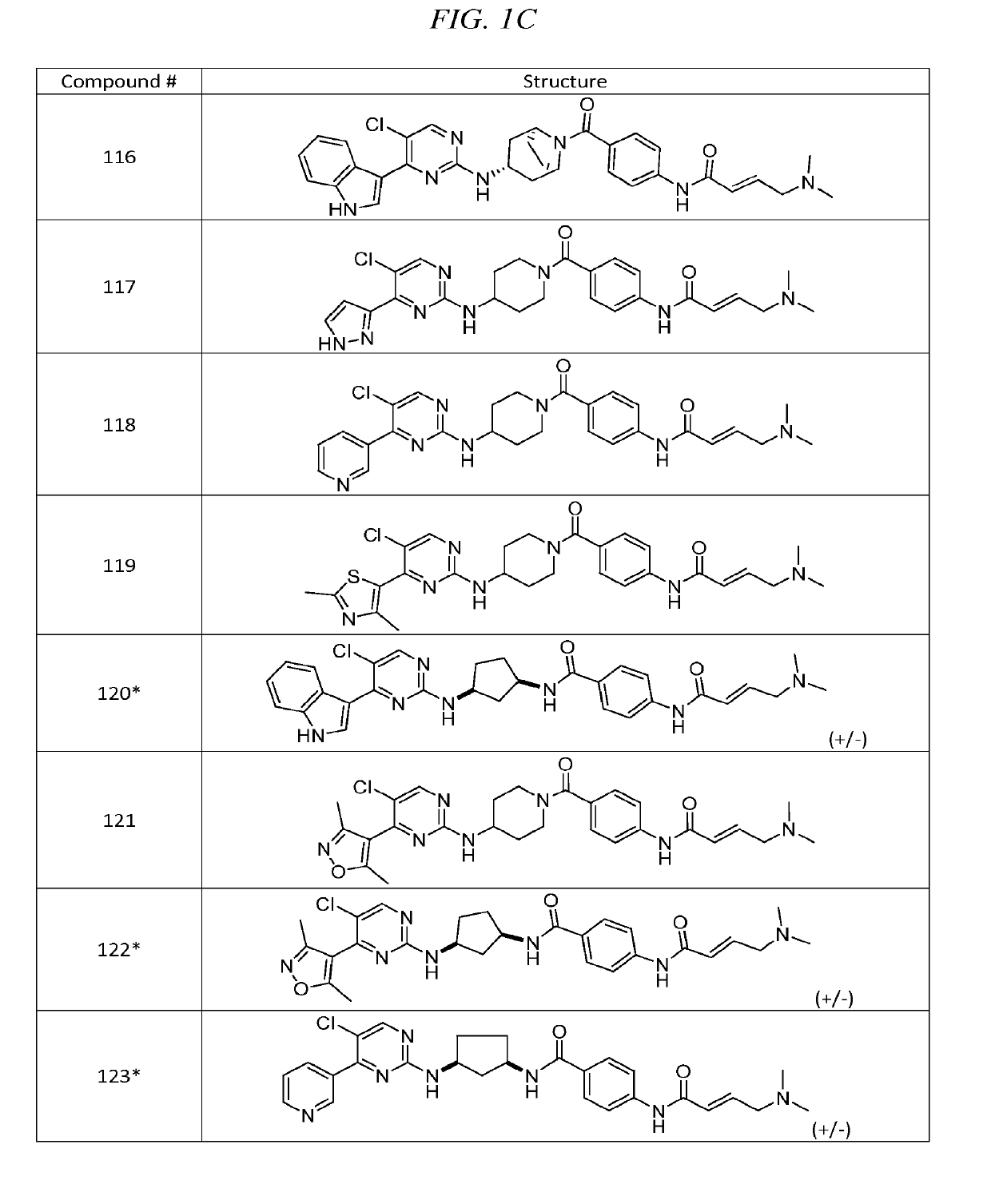Heteroaromatic compounds useful for the treatment of proliferative diseases
a technology of heteroaromatic compounds and proliferative diseases, applied in the direction of drug compositions, organic chemistry, organic active ingredients, etc., can solve the problems of hampered discovery of selective inhibitors of cdk7 and anti-proliferative activity
- Summary
- Abstract
- Description
- Claims
- Application Information
AI Technical Summary
Benefits of technology
Problems solved by technology
Method used
Image
Examples
example 1
of (E)-N-(4-(4-(5-chloro-4-(1H-indol-3-yl)pyrimidin-2-ylamino)piperidine-1-carbonyl)phenyl)-4-(dimethylamino)but-2-enamide (Compound 100)
p-{[4-(Benzyloxycarbonylamino)-1-piperidyl]carbonyl}phenylamino 2,2-dimethylpropionate
[0212]
[0213]To a solution of 4-(tert-butoxycarbonylamino)benzoic acid (500 mg, 2 mmol), 4-CBz-aminopiperidine (500 mg, 2 mmol) and Et3N (0.89 ml, 6 mmol) in DMSO (10 mL) was added HBTU (1.2 g, 3 mmol) and the mixture was stirred 12 h at rt. The reaction was then diluted with EtOAc (100 ml) and water (100 mL). The layers were separated and the organic layer was washed with brine (3×100 mL). The organic layer was dried (MgSO4), filtered and concentrated under reduced pressure. The residue was purified by SiO2 chromatography (DCM / MeOH, 0 to 10% gradient) and afforded the title compound as a white solid (850 mg, 87.8%)
tert-butyl 4-(4-aminopiperidine-1-carbonyl)phenylcarbamate
[0214]
[0215]To a degassed solution of p-{[4-(Benzyloxycarbonylamino)-1-piperidyl]carbonyl}phen...
example 2
of (E)-N-(4-((S)-3-(5-chloro-4-(1H-indol-3-yl)pyrimidin-2-ylamino)pyrrolidine-1-carbonyl)phenyl)-4-(dimethylamino)but-2-enamide (Compound 101)
(3S)-tert-butyl 3-(5-chloro-4-(1-(phenylsulfonyl)-1H-indol-3-yl)pyrimidin-2-ylamino)pyrrolidine-1-carboxylate
[0224]
[0225]A solution of 3-(2,5-dichloropyrimidin-4-yl)-1-(phenylsulfonyl)-1H-indole (400 mg, 0.99 mmol), (S)-tert-butyl 3-aminopyrrolidine-1-carboxylate (193 mg, 1.04 mmol) and DIPEA (172 μL, 0.99 mmol) in NMP (2.64 mL) was heated at 135° C. (mW) for 15 min. After being cooled to rt, the reaction mixture was diluted with EtOAc (10 mL), washed with water (5 mL), brine (5 mL), dried (MgSO4), filtered and concentrated under reduced pressure. The residue was purified by SiO2 flash chromatography (Hex / EtOAc 0 to 100% gradient) and afforded the title compound (492 mg, 0.89 mmol, 85%) as a white solid.
5-chloro-4-(1-(phenylsulfonyl)-H-indol-3-yl)-N—((S)-pyrrolidin-3-yl)pyrimidin-2-amine.TFA
[0226]
[0227]A solution of (3S)-tert-butyl 3-(5-chloro...
example 3
(4-(5-cyano-4-(1H-indol-3-yl)pyrimidin-2-ylamino)piperidine-1-carbonyl)phenyl)-4-(dimethylamino)but-2-enamide (Compound 102)
2-(1-(4-aminobenzoyl)piperidin-4-ylamino)-4-(1-(phenylsulfonyl)-1H-indol-3-yl)pyrimidine-5-carbonitrile
[0236]
[0237]A suspension of (4-aminophenyl)(4-(5-chloro-4-(1-(phenylsulfonyl)-1H-indol-3-yl)pyrimidin-2-ylamino)piperidin-1-yl)methanone prepared as in Example 1 (187 mg, 0.319 mmol), zinc dust (2.1 mg, 0.03 mmol), Pd2dba3 (29.2 mg, 0.03 mmol), Xphos (30.4 mg, 0.06 mmol) and zinc cyanide (22.4 mg, 0.19 mmol) in degassed DMA (4.25 mL) was stirred 2 h at 95° C. The cooled mixture was diluted with EtOAc (20 mL) and washed with water (3×5 mL), brine (5 mL), dried (MgSO4), filtered and concentrated under reduced pressure. The resulting compound was purified on SiO2 chromatography (DCM / MeOH 1 to 10% gradient) and afforded the title compound (184 mg, 0.319 mmol, 100%) as a white solid.
2-(1-(4-aminobenzoyl)piperidin-4-ylamino)-4-(1H-indol-3-yl)pyrimidine-5-carbonitril...
PUM
 Login to View More
Login to View More Abstract
Description
Claims
Application Information
 Login to View More
Login to View More - R&D
- Intellectual Property
- Life Sciences
- Materials
- Tech Scout
- Unparalleled Data Quality
- Higher Quality Content
- 60% Fewer Hallucinations
Browse by: Latest US Patents, China's latest patents, Technical Efficacy Thesaurus, Application Domain, Technology Topic, Popular Technical Reports.
© 2025 PatSnap. All rights reserved.Legal|Privacy policy|Modern Slavery Act Transparency Statement|Sitemap|About US| Contact US: help@patsnap.com



